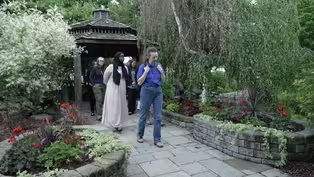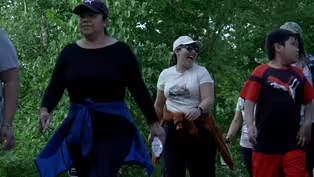Prairie Sportsman
Superior Agates on the Croix
Clip: Season 16 Episode 3 | 8m 58sVideo has Closed Captions
Hunting for Lake Superior agates along the St. Croix River.
Eric Benson has been hunting for Lake Superior agates along the St. Croix River for the past seven years. The avid angler searches for the semi-precious stones when the fish aren’t biting and has amassed an impressive collection. Agates were formed a billion years ago by volcanic eruptions from Lake Superior to Mille Lacs Lake. Glacial movement deposited the agates all the way down to Nebraska.
Problems playing video? | Closed Captioning Feedback
Problems playing video? | Closed Captioning Feedback
Prairie Sportsman is a local public television program presented by Pioneer PBS
Production sponsorship is provided by funding from the Environment and Natural Resources Trust Fund, West Central Initiative, Shalom Hill Farm, and members of Pioneer PBS.
Prairie Sportsman
Superior Agates on the Croix
Clip: Season 16 Episode 3 | 8m 58sVideo has Closed Captions
Eric Benson has been hunting for Lake Superior agates along the St. Croix River for the past seven years. The avid angler searches for the semi-precious stones when the fish aren’t biting and has amassed an impressive collection. Agates were formed a billion years ago by volcanic eruptions from Lake Superior to Mille Lacs Lake. Glacial movement deposited the agates all the way down to Nebraska.
Problems playing video? | Closed Captioning Feedback
How to Watch Prairie Sportsman
Prairie Sportsman is available to stream on pbs.org and the free PBS App, available on iPhone, Apple TV, Android TV, Android smartphones, Amazon Fire TV, Amazon Fire Tablet, Roku, Samsung Smart TV, and Vizio.

Prairie Sportsman Premium Gifts
Do you love the great outdoors, hunting, fishing, hiking and conservation? Consider becoming a friend of Prairie Sportsman to support it and receive gifts with your contribution.Providing Support for PBS.org
Learn Moreabout PBS online sponsorship(lively rock music) - [Bret] Eric Benson has spent countless hours fishing the St. Croix River since he moved to the valley 30 years ago.
- All right.
(upbeat music) - [Bret] But when the fish aren't biting, you might find them on the banks of the river searching for semi-precious stones.
(lively music) (upbeat rock music) - Agates were formed a billion years ago when Minnesota was under a lot of volcanoes, all the way up to Lake Superior down to Mille Lacs, and then they were brought down, and deposited with the Ice Ages.
And you can find Lake Superior agates in Minnesota, Wisconsin, down to Iowa, even Nebraska.
You go to stores and you'll see agates like from Madagascar and they're fairly cheap because they're from Madagascar.
They're Lake Superior agates that seem to be worth a lot of money.
Not a lot, but better than a lump of coal.
(lively music) I just like looking for 'em and just collecting 'em and making my pile of rocks bigger.
I started agate hunting with my friend Kevin Simonet about seven years ago and that first summer I didn't find much but I bugged the hell out of him saying, "Is this an agate?"
"Nope, nope."
And when I'd go out on my own, I'd bring back tons of rocks that weren't agates.
But after the first year, I kind of got an eye for it and then I just got obsessed with it (Eric laughs) so...
This is seven years of hiking miles and miles.
But it's fun, it's something to do.
If I'm not fishing on the river, I'm usually out looking for rocks.
- [Bret] Last summer we joined Eric for a morning of agate hunting along the St. Croix.
- It's just all about looking.
You get in the water here and it is pretty clear.
They're tough to see in the water but they are there, there's like four feet of rocks that are always nice and clean as you go out deeper, they're kind of got moss on them, but there's always tons of rocks on the beach.
And what's this by your foot?
It's an agate wanna be, it's not an agate.
Agate wanna be.
It's called leave it right.
Leave it right there.
(everyone laughs) (peaceful music) (water lapping) Ah, first one little guy.
You're kind of looking for a red, reddish waxy rock.
What helps looking at rocks in the water are polarized glasses, really helps.
And then to keep your eyes shaded as much from the sun, just makes things pop more.
And every time it floods, it just exposes new rocks and stir things around, you just never know.
A killer agate could be here anywhere.
The water's this high up here don't even bother.
But every time it goes down it just the waves exposes new rocks, brings more debris down from the side.
And you can tell by these tree roots, you know, the soil was used to be this high.
You know, that's how much it eroded away so all that's left are the heavy rocks.
Better than agate, a lure add to my collection.
My mom always said I could always find stuff, if she lost something aroun the house, I'd always find it.
So yeah, we're always looking for stuff, always got our eyes to the ground.
I remember coming here one day and I swear there was an agate just sitting right on top of a rock.
A nice agate, it was like, how did that get there and how did no one see it?
Cause I know people walked as you can see other people's footprints.
(calming music) No way!
Whoa, oh wow, there it is yeah.
I'm glad we walked down this far.
That was worth the walk today, that one.
(lo-fi music) - [Bret] With a trophy agate in tow, we headed to Eric's Stillwater home, which he shares with his wife Eileen.
There he displayed his impressive collection of Lake Superior agates.
- I wish these were gold nuggets, I'd be retired a million times over but they're not.
You're actually the first people that really seen them, some of my closest friends and family, and these are some of the agates I found in the St. Croix Valley along the river, out in farm fields, construction sites.
This is one of my favorites I don't know where I found it.
This one here, I remember where I found that it was sticking on top of a plowed furrow, sticking up like a lantern.
I have found all these agates in Washington County.
Why drive when they you got 'em here?
The ones in the pan here, is this year's collection that I've found so far.
I like to go in the spring before...
Especially in the fields, before the crops are up.
And then again in late fall after crop's been picked.
And every time the fields get turned over, it seems like there's a new collection of agates to be found.
And I do have permission, the fields that I do go to, you don't want to get caught trespassing.
Now if I had access to quarries, I'm sure that'd be the number one spot to go but I don't have access to quarries.
Other spots to find 'em are along roads, housing developments, and in landscaping like landscape, rocks, river rocks, especially on older properties.
You'd be surprised if you dig around your neighbor's, he has river rock for landscaping, you will find agates if you look hard enough.
This is a cool agate that I found before it got buried into development it's an eyeball agate.
People kind of go crazy after that one there.
They're all unusual in a way, like that one's like a kind of a neat one, it's like a flat tablet type.
And the lines weren't really profound until I polished it up really good and it turned out to be pretty cool.
I've taken hammers to 'em, broken 'em open and turned a dull rock into a kind of nice ones, you know?
It wasn't much of an agate until I... Like this one that's what it looked like outside and I split it in half and that was in the center.
That's another one I broke in half, took a chisel to it, see what's inside and that's what I found inside that one.
This what they call a water level 'cause the lines going across.
I found this in a field not too far from here, it's been polished down.
When you polish agates, you usually lose about 30% of the rock.
(cheery music) This is a tumbler that I use to polish agates.
It's a simple tumbler's tumbler, if you do buy a tumbler, get a good quality one.
Don't buy a cheap one 'cause it'll fail on you.
There's four stages there's a course one, which is the first step and each cycle takes at least seven days.
And generally you fill th barrels up two thirds with rocks add your measured grit and add water just to cover the rocks, put the lid on tight, and you just let it spin for about a week.
You take 'em out, clean 'em real good, clean the barrels real good.
Do step two for a week, take 'em out, clean 'em up good.
And then you're onto step three, which is a pre-polish.
Every step you'll see your rocks get smaller and smaller but that's all right.
I mean that's just the grit wearing down on the rocks, like a million years of being in the dirt to make 'em nice and shiny.
I don't know if polish 'em devalues 'em like furniture when you strip the old finish off, but it doesn't matter to me, I just like looking at 'em and collecting them.
And then the final step, you wanna make sure your rocks are real clean, and add the final step.
And after four weeks you'l have some nice polished agates.
(cheerful music) 30 years of fishing and seven years of agate hunting and I hope my knees keep up so I can do both of 'em until I'm well into my eighties or whatever.
I have no idea where I want my collection to go.
I got no kids, maybe you ca throw 'em in the grave with me.
(cheerful music)
Agates and Nature's Healing Benefits
Video has Closed Captions
Preview: S16 Ep3 | 30s | Agate hunting on the St. Croix River, forest therapy and Huellas Latinas. (30s)
Video has Closed Captions
Clip: S16 Ep3 | 8m 13s | Forest therapy’s mental health benefits. (8m 13s)
Video has Closed Captions
Clip: S16 Ep3 | 8m 31s | Huellas Latinas connects Spanish-speaking people to outdoor recreation. (8m 31s)
Providing Support for PBS.org
Learn Moreabout PBS online sponsorship
- Science and Nature

Explore scientific discoveries on television's most acclaimed science documentary series.

- Science and Nature

Capturing the splendor of the natural world, from the African plains to the Antarctic ice.












Support for PBS provided by:
Prairie Sportsman is a local public television program presented by Pioneer PBS
Production sponsorship is provided by funding from the Environment and Natural Resources Trust Fund, West Central Initiative, Shalom Hill Farm, and members of Pioneer PBS.




